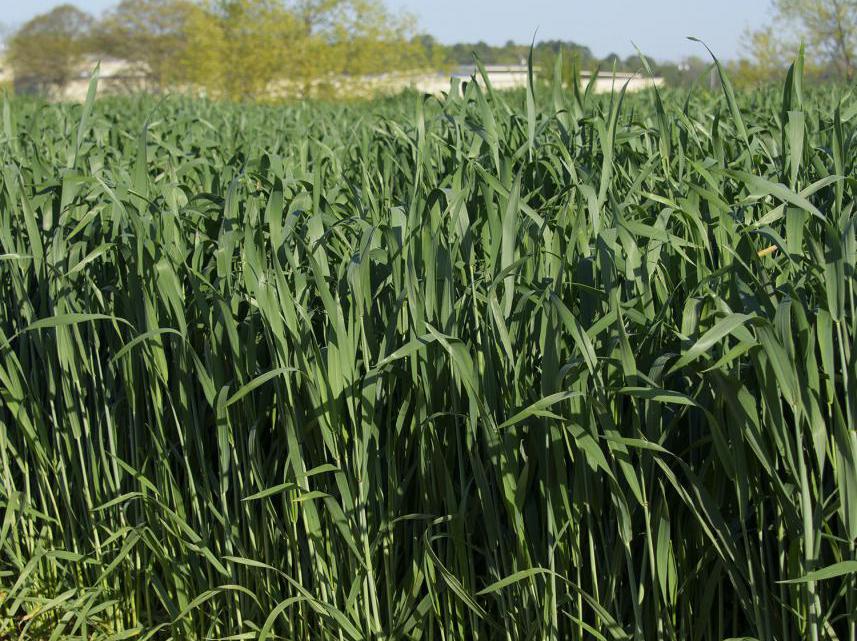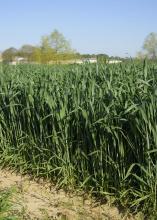Information Possibly Outdated
The information presented on this page was originally released on April 8, 2016. It may not be outdated, but please search our site for more current information. If you plan to quote or reference this information in a publication, please check with the Extension specialist or author before proceeding.
Floods, planting conditions limit state’s wheat crop
STARKVILLE, Miss. -- Winter conditions did not significantly affect wheat development in Mississippi, but acreage of the state’s only cold-season row crop is expected to be much lower than normal due to poor planting conditions last fall.
Erick Larson, corn and wheat specialist with the Mississippi State University Extension Service, said 90,000 acres of wheat were planted last fall. The normal acreage is usually around 200,000 acres. Producers planted 230,000 acres in 2014 and 150,000 acres in 2013.
 Wheat is shown growing in a R.R. Foil Plant Science Research Center test plot at Mississippi State University April 6, 2016. Due to poor planting conditions and a saturated market last fall, producers planted only 90,000 acres of the state’s winter crop, which is less than half of the 200,000-acre average. (Photo by MSU Extension Service/Kevin Hudson)
Wheat is shown growing in a R.R. Foil Plant Science Research Center test plot at Mississippi State University April 6, 2016. Due to poor planting conditions and a saturated market last fall, producers planted only 90,000 acres of the state’s winter crop, which is less than half of the 200,000-acre average. (Photo by MSU Extension Service/Kevin Hudson)“What we have planted looks fair to good, but this is going to be a down year overall for wheat,” Larson said. “We had an unusual fall in that we were extremely dry in October, which is the optimal wheat planting time in much of the state. We then received significant rainfall in early November and thereafter. Those two patterns restricted planting substantially. It’s odd to go from being too dry to plant to too wet to put a tractor in the field in such a short time period.”
Rainfall has continued to be an issue throughout the winter, with widespread floods inundating much of the state last month. The wheat crop felt the effects of the heavy rains.
“There were two huge rainfall events during March that caused considerable flooding and soil saturation across most of the state, including the Delta and north Mississippi, where most of the wheat is grown,” Larson said. “Right now, we have a fair amount of stripe rust, which is a serious disease that can cause major wheat yield loss. Extension agents and faculty are scouting for the disease and making control recommendations when necessary. Stripe rust thrives in cool, wet weather. The conditions we had in March have been very conducive to the disease.”
While low temperatures last year caused wheat to break dormancy later than usual, crop growth and development have been fairly normal this year, resuming spring growth in mid- to late February. There were multiple frosty nights after that time, but they did not get cold enough to harm the wheat yield.
“Wheat is just now getting to the heading stage, when it is the most vulnerable, and barring a late freeze, temperatures will not compromise this year’s harvest,” Larson said. “The older wheat is at the time of a late-spring freeze, the more likely you are to see catastrophic losses. Hopefully, we will avoid that.”
Brian Williams, Extension agricultural economist, said cash wheat prices in Greenville were $4.61 a bushel as of April 1, down more than 60 cents from this time last year. July wheat futures were trading at $4.83 at the end of March.
Williams said the currently high worldwide wheat supply is keeping prices low, but markets and traders are evaluating conditions as the crop comes out of dormancy in other regions.
“Wheat market prices are generally highest in the late spring before harvesting in the summer drives prices down,” he said. “The biggest driver of wheat prices right now is that there are large global wheat stocks. There is a lot of grain sitting in storage -- almost too much. Several major global wheat producers had good years in 2015.”




